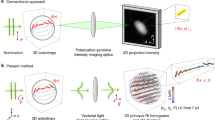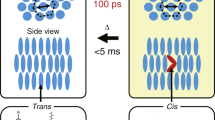Abstract
THE action of plane-polarised light on anisotropically absorbing molecules produces an induced anisotropy in an ensemble of molecules, which can be detected by double refringence, dichroism and other optical phenomena. The phenomenon was first observed1 on dye molecules in liquid2, although its nature and mechanism by which it operates remain unexplained—neither can they be explained by the optical Kerr effect2.
This is a preview of subscription content, access via your institution
Access options
Subscribe to this journal
Receive 51 print issues and online access
$199.00 per year
only $3.90 per issue
Buy this article
- Purchase on Springer Link
- Instant access to full article PDF
Prices may be subject to local taxes which are calculated during checkout
Similar content being viewed by others
References
Teitel, A., Naturwissenschaften, 44, 370 (1957).
Neporent, B., and Stolbova, O., Optika Spektrosk., 10, 287 (1961); 14, 624 (1963).
Schubert, M., and Wilhelmi, B., Einführung in die nichtlineare Optik (Teubner Verlagsgesellschaft, Leipzig, 1971).
Author information
Authors and Affiliations
Rights and permissions
About this article
Cite this article
ROMANOVSKIS, T., SMITS, O. Photo-orientation of anisotropically absorbing molecules. Nature 258, 137–138 (1975). https://doi.org/10.1038/258137a0
Received:
Accepted:
Issue Date:
DOI: https://doi.org/10.1038/258137a0
Comments
By submitting a comment you agree to abide by our Terms and Community Guidelines. If you find something abusive or that does not comply with our terms or guidelines please flag it as inappropriate.



